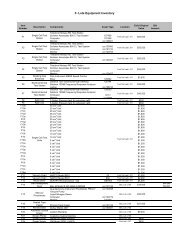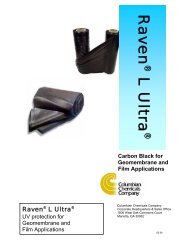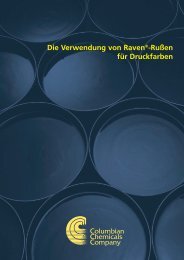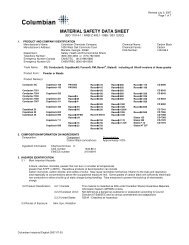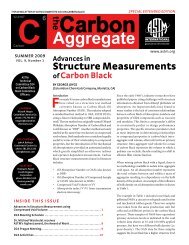Typical Properties of Industrial Carbon Blacks - Columbian Chemicals
Typical Properties of Industrial Carbon Blacks - Columbian Chemicals
Typical Properties of Industrial Carbon Blacks - Columbian Chemicals
Create successful ePaper yourself
Turn your PDF publications into a flip-book with our unique Google optimized e-Paper software.
A carbon black's application performance<br />
is determined by its nature and<br />
the level <strong>of</strong> dispersion achieved. The<br />
most important physical and chemical<br />
properties include particle size,<br />
surface area, porosity, structure,<br />
surface chemistry, and physical form.<br />
The level <strong>of</strong> dispersion in any given<br />
formulation is strongly influenced by<br />
the mixing equipment and procedures<br />
used.<br />
PARTICLE SIZE exerts a primary<br />
<strong>Carbon</strong> black particle<br />
showing Paracrystalline<br />
microstructure �<br />
�<br />
<strong>Carbon</strong> black<br />
aggregate - the<br />
true primary unit<br />
<strong>of</strong> carbon black<br />
influence<br />
on color<br />
properties.<br />
Finer particle<br />
size<br />
leads to<br />
j e t t e r<br />
(darker)<br />
color and<br />
higher<br />
viscosity, but requires increased<br />
dispersion energy. Particle size is<br />
measured by electron microscopy.<br />
SURFACE AREA is used for quality<br />
control purposes and is a function <strong>of</strong><br />
the carbon black's particle size and<br />
porosity. Smaller particle diameter<br />
gives rise to higher surface area. High<br />
surface area is usually associated<br />
with greater blackness and higher<br />
viscosity.<br />
POROSITY is indicated by comparing<br />
a carbon black's external surface area<br />
predicted by EMSA, and STSA, to the<br />
total surface area value obtained<br />
with the BET NSA method. High color<br />
and conductive carbon blacks tend<br />
to have a high degree <strong>of</strong> porosity.<br />
STRUCTURE is a measure <strong>of</strong> the<br />
three-dimensional fusion <strong>of</strong> carbon<br />
black particles to form aggregates.<br />
Highly structured carbon blacks<br />
provide higher viscosity, greater<br />
electrical conductivity and easier<br />
dispersion. Measures <strong>of</strong> aggregate<br />
structure may be obtained from<br />
shape distributions from EM analysis,<br />
or oil absorption (OAN).<br />
SURFACE CHEMISTRY <strong>of</strong> <strong>Industrial</strong><br />
<strong>Carbon</strong> <strong>Blacks</strong> generally refers to the<br />
oxygen-containing groups present<br />
on a carbon black's surface. Oxidized<br />
surfaces improve wettability,<br />
rheology and dispersion in selected<br />
vehicle systems. In other cases, oxidation<br />
increases electrical resistivity<br />
and makes carbon blacks more<br />
hydrophilic.The extent <strong>of</strong> surface oxidation<br />
is measured by determining<br />
the quantity <strong>of</strong> the “volatile” component<br />
on the carbon black. High<br />
volatile levels are associated with low<br />
pH. A number <strong>of</strong> Raven® carbon<br />
blacks are post-treated to provide<br />
enhanced surface functionality.<br />
PHYSICAL FORM is important in<br />
matching a carbon black to the<br />
equipment by which it is to be<br />
dispersed. Powdered carbon blacks<br />
are recommended in low-shear<br />
dispersers and on three-roll mills.<br />
Beaded carbon blacks are recommended<br />
for shot mills, ball mills and<br />
other high energy equipment.<br />
Beading provides lower dusting, bulk<br />
handling capabilities, higher bulk<br />
densities and improved economics,<br />
while powdered carbon blacks <strong>of</strong>fer<br />
improved dispersibility.<br />
FUNDAMENTAL CARBON BLACK PROPERTIES INFLUENCE OF CARBON PROPERTIES ON APPLICATIONS PERFORMANCE<br />
Fineness - Particle Size Distribution Smaller Particle Size (Higher Surface Area)<br />
Increases Blackness<br />
Increases Tint<br />
Increases UV Protection<br />
Increases Electrical Conductivity<br />
Increases Vehicle Demand and Viscosity<br />
Reduces Dispersibility<br />
Structure - Aggregate Size/Shape Distribution Higher Structure (Increasing Oil Absorption )<br />
Reduces Blackness and Tint<br />
Improves Dispersibility<br />
Increases Vehicle Demand and Viscosity<br />
Increases Electrical Conductivity<br />
Porosity - Pore Size Distribution Higher Porosity (Higher ratio <strong>of</strong> NSA/STSA)<br />
H<br />
H<br />
Increases Vehicle Demand and Viscosity<br />
Increases Electrical Conductivity<br />
Enables Reduced Loadings in Conductive Applications<br />
Surface Chemistry - Surface Functionality Distribution Higher Surface Functionality (Higher Volatile)<br />
H<br />
H<br />
H<br />
H<br />
H<br />
H<br />
H<br />
H<br />
H<br />
H<br />
Improves Vehicle Wetting<br />
Reduces Viscosity <strong>of</strong> Liquid Systems<br />
Lowers Electrical Conductivity<br />
Additional <strong>Properties</strong><br />
Other Constituents - Sulfur, Ash, Residue, Etc. Physical Form - Beads or Powder<br />
FOR CARBON BLACK RECOMMENDATIONS BEST SUITED FOR YOUR APPLICATIONS, CONTACT YOUR COLUMBIAN TECHNICAL REPRESENTATIVE



